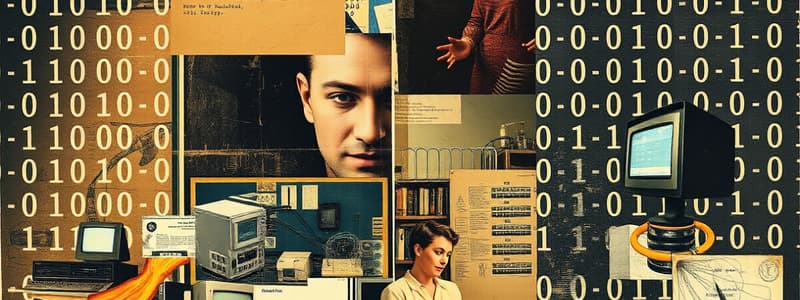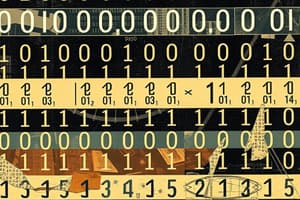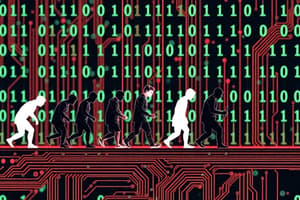Podcast
Questions and Answers
What is the main advantage of encoding data in binary language?
What is the main advantage of encoding data in binary language?
- It simplifies the design of hardware.
- It makes it harder for computers to process data.
- It eliminates the need for software.
- It allows computers to process data efficiently. (correct)
The central processing unit (CPU) is made up of millions of transistors.
The central processing unit (CPU) is made up of millions of transistors.
True (A)
What does GUI stand for?
What does GUI stand for?
Graphic User Interface
ROM chips are used for ______ data.
ROM chips are used for ______ data.
Match the types of memory with their characteristics:
Match the types of memory with their characteristics:
Which of the following is NOT considered an input device?
Which of the following is NOT considered an input device?
A flash drive connects to the computer using a universal serial bus (USB).
A flash drive connects to the computer using a universal serial bus (USB).
What is the primary function of an operating system?
What is the primary function of an operating system?
Microsoft Windows improved upon DOS by adding a ______ user interface.
Microsoft Windows improved upon DOS by adding a ______ user interface.
What is one of the features that Windows added to improve upon DOS?
What is one of the features that Windows added to improve upon DOS?
Which component is primarily responsible for processing data in a computer?
Which component is primarily responsible for processing data in a computer?
ROM chips are used to store data that can change frequently.
ROM chips are used to store data that can change frequently.
What type of connection does a flash drive typically use to connect to a computer?
What type of connection does a flash drive typically use to connect to a computer?
Input devices include a keyboard and a ______.
Input devices include a keyboard and a ______.
What major improvement did Microsoft Windows introduce over DOS?
What major improvement did Microsoft Windows introduce over DOS?
Match the type of memory with its description:
Match the type of memory with its description:
Which of the following is NOT a peripheral device?
Which of the following is NOT a peripheral device?
The boot sequence instructions are responsible for executing applications on the computer.
The boot sequence instructions are responsible for executing applications on the computer.
What is the purpose of the operating system in a computer?
What is the purpose of the operating system in a computer?
The CPU is embedded in the motherboard and connects to other hardware through ______.
The CPU is embedded in the motherboard and connects to other hardware through ______.
Flashcards are hidden until you start studying
Study Notes
Evolution of Computing Technology
- Calculating machines date back centuries, forming the foundation of modern computing.
- Computers process data most efficiently using binary language (1s and 0s).
Hardware Development
- Technology transitioned from vacuum tubes to solid-state processors.
- Input methods evolved from paper tape to graphic user interfaces (GUIs), like Windows.
- Central Processing Unit (CPU) comprises millions of transistors, crucial for data processing.
- CPU is integrated into the motherboard, connecting various hardware components.
Computer Components
- Peripheral devices include speakers and modems, enhancing computer functionality.
- Universal Serial Bus (USB) serves as a standardized connection for devices like flash drives.
- Input devices are essential for data submission, including:
- Keyboards for text input.
- Modems for network connections.
- Scanners to convert printed information into digital format.
Data Storage Solutions
- Memory types include:
- ROM (Read-Only Memory) for permanent data.
- RAM (Random Access Memory) for temporary, changeable data.
- Mass storage options:
- Hard drives for large data capacity.
- Flash drives, portable storage devices connecting via USB.
Software Functionality
- Key software elements include:
- Boot sequence instructions for computer start-up.
- Operating systems (OS) manage user applications and provide GUIs.
- Microsoft Windows OS advancements include:
- Introduction of graphical user interfaces and Plug and Play functionality.
- Central registry for managing system settings.
- Transition from 32-bit to 64-bit computing for improved performance.
Evolution of Computing Technology
- Calculating machines date back centuries, forming the foundation of modern computing.
- Computers process data most efficiently using binary language (1s and 0s).
Hardware Development
- Technology transitioned from vacuum tubes to solid-state processors.
- Input methods evolved from paper tape to graphic user interfaces (GUIs), like Windows.
- Central Processing Unit (CPU) comprises millions of transistors, crucial for data processing.
- CPU is integrated into the motherboard, connecting various hardware components.
Computer Components
- Peripheral devices include speakers and modems, enhancing computer functionality.
- Universal Serial Bus (USB) serves as a standardized connection for devices like flash drives.
- Input devices are essential for data submission, including:
- Keyboards for text input.
- Modems for network connections.
- Scanners to convert printed information into digital format.
Data Storage Solutions
- Memory types include:
- ROM (Read-Only Memory) for permanent data.
- RAM (Random Access Memory) for temporary, changeable data.
- Mass storage options:
- Hard drives for large data capacity.
- Flash drives, portable storage devices connecting via USB.
Software Functionality
- Key software elements include:
- Boot sequence instructions for computer start-up.
- Operating systems (OS) manage user applications and provide GUIs.
- Microsoft Windows OS advancements include:
- Introduction of graphical user interfaces and Plug and Play functionality.
- Central registry for managing system settings.
- Transition from 32-bit to 64-bit computing for improved performance.
Studying That Suits You
Use AI to generate personalized quizzes and flashcards to suit your learning preferences.




